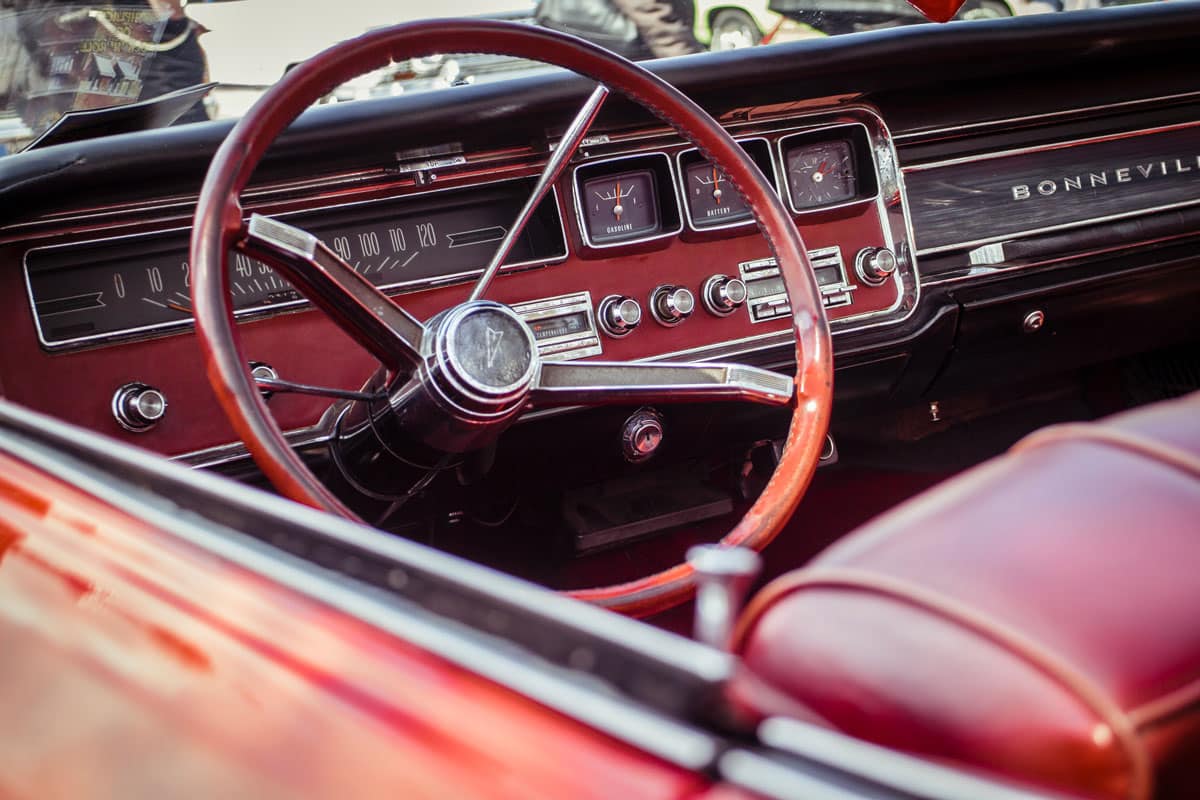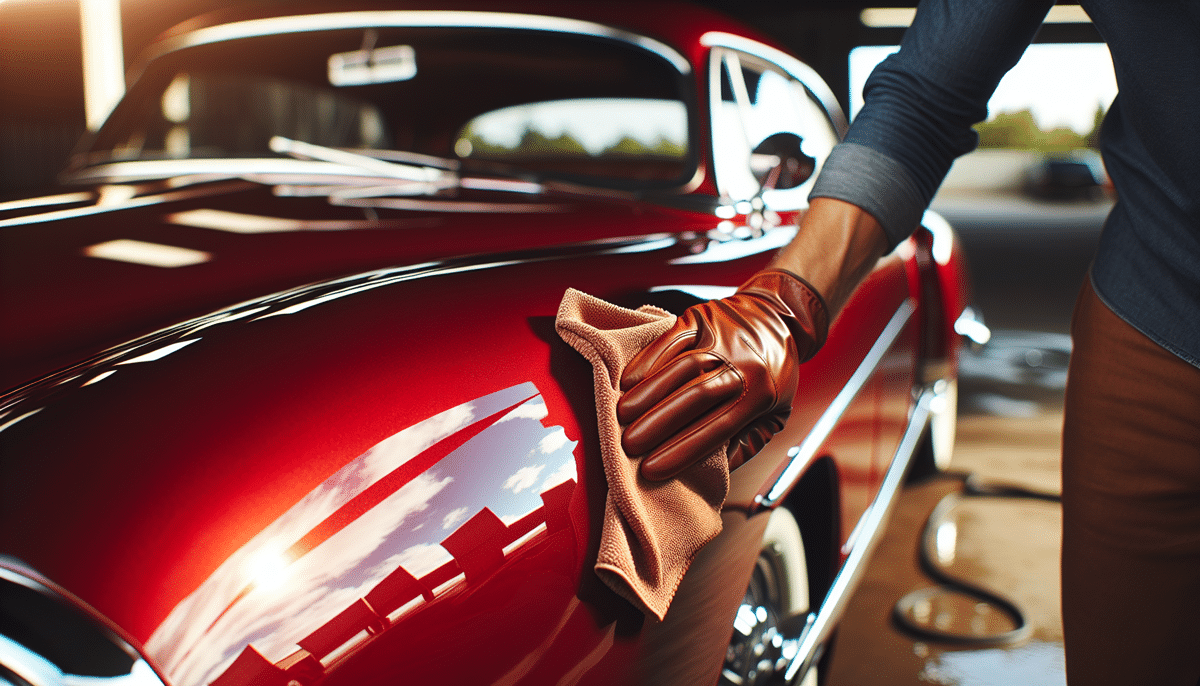Looking for the best ways to get a classic car wash sparkle without worrying about messing up your vintage paint? Washing your classic car isn’t just about suds and water—it’s about choosing the right products and applying careful techniques that preserve your car’s integrity while restoring its shine. In this article, we’ll guide you through the essentials: selecting gentle cleaning agents, employing non-damaging washing methods, and the tools that will keep your classic car in show-worthy condition.

Key Takeaways
- Use pH-balanced shampoos and chrome-specific cleaners to wash classic cars, avoiding harsh detergents that can damage the paint and chrome finishes.
- Employ gentle washing techniques using soft microfiber towels or mitts, the two-bucket method for washing, and careful rinsing at the right water temperature to prevent scratches and water spots.
- Keep the interior pristine with specialized products for leather care, dashboard and door panel maintenance, and streak-free window cleaning, and protect your car post-wash with wax, sealants, and proper drying methods.
Table of Contents
Choosing the Right Cleaning Agents for Classic Cars
As a classic car owner, you understand that these vintage rides need more than just a clean-up. They require special care to preserve their original look. You’ve worked so hard to bring that vintage paint back to life and you want to keep it looking great! That’s why we suggest hand washing to keep that vintage car clean!
A crucial step in maintaining a classic car involves selecting suitable cleaning agents. Similar to how you wouldn’t clean a silk scarf with a harsh laundry detergent, you should avoid washing your classic car with substances that could harm its vintage paint or delicate chrome.
pH-Balanced Car Shampoos
The shampoo selection for washing your classic car can drastically impact the outcome, a shiny, spotless finish or a dull, damaged exterior. Just as your skin has a specific pH level, so does your car’s paint. Using a pH-balanced car shampoo is essential to maintaining the integrity of the paint job. These shampoos are specifically designed to clean without being overly abrasive, protecting the paint while still effectively removing dirt and grime.
But not all pH-balanced car shampoos are created equal. Some top-rated options for classic cars include:
If you’re feeling adventurous, you could even make your own pH-balanced car shampoo at home with simple ingredients like coconut milk, baking soda, and castile soap! It’s hard to believe that with just a few household ingredients, you could create a safe and effective wash for your classic ride?
Chrome-Specific Cleaners
Chrome is like the jewelry of a classic car, adding that extra sparkle and shine. But just like jewelry, it needs special care to keep it looking its best. This is where chrome-specific cleaners come into play. These cleaners are designed to safely clean chrome surfaces without scratching or dulling them. And just like the pH-balanced shampoo, using the right cleaner can make a world of difference in maintaining the gleaming charm of your classic car.
Some of the popular choices for chrome cleaners include Mothers Mag and Aluminum Polish for scuzzy chrome and Turtle Wax Leather Cleaner & Conditioner for leather surfaces. If you notice minor rusting on the chrome, don’t panic! A gentle scrub with #0000 steel-wool can help remove the rust and restore the chrome’s shine. Just make sure to follow up with a good chrome polish after each wash to keep your ride shining bright.
Avoiding Harmful Detergents
Knowing what not to use on your classic car is equally important as knowing what to use. Harsh detergents can erode the wax and damage the clear coat, resulting in faded and dull paint. Therefore, it’s vital to avoid such detergents when washing your classic car.
These harmful detergents often contain strong chemicals that can be abrasive, leading to surface scratches and a worn-out look over time. Instead, opt for gentler options like Simply Green. Remember, the goal is to clean your car without causing any damage, and the right cleaning agent will help you achieve just that.
Gentle Washing Techniques for Vintage Vehicles
Having covered the significance of selecting the right cleaning products for your classic car, we now turn our attention to the correct washing techniques. Employing gentle washing techniques is essential in preserving the aesthetics of a classic car. Using soft materials and mindful methods like the two-bucket wash can help ensure that the paint remains unscathed during the cleaning process. To wash a classic car properly and keep your paint job looking fresh, it’s crucial to follow these guidelines especially if you’re using your classic car or truck as a daily driver.
Soft Microfiber Towel Usage to Protect Your Vintage Paint
One straightforward method to ensure a gentle wash includes the use of soft cloth microfiber towels or cotton chenille washing mitts. These towels and mitts are specifically designed to be kind to your car’s paint, thereby reducing the likelihood of scratches and swirl marks. Plus, they’re super absorbent, making them perfect for drying your car without leaving any streaks or lint behind.
Taking care of your microfiber cloths and towels is just as important as using them. Make sure to wash them in cold or warm water, not too hot, to keep them in good shape. Always start with a clean towel and use it with the right pressure to avoid scratching the paint. After all, your car deserves nothing but the best care, right?
The Two-Bucket Wash Method
The two-bucket hand washing method is another essential technique. As implied by its name, this method requires two buckets – one filled with soapy water and another with clean water for rinsing. Why two buckets, you ask? Well, using a separate bucket for rinsing ensures that you’re not spreading the dirt and grime you just washed off back onto the car. This helps prevent scratches and swirl marks that could mess up your car’s paint job.
To use the two-bucket wash method when you wash your car, you’ll need two buckets (of course!), a good quality mitt, premium towels, and a dirt trap. Start by dipping your mitt into the soapy water, clean a section of the car, then rinse the mitt in the clean water before going back to the soapy water. It’s a simple yet effective method to ensure a scratch-free wash for your ride.
Rinsing with Care
Rinsing is a crucial step in the car washing process. If performed correctly, it can leave your car impeccably clean with no water spots or streaks. The key to a perfect rinse is to wet the car first to get rid of any loose dirt and grime. This reduces the chance of scratches during the wash. And for drying, it’s best to use a microfiber drying towel or waffle weave towel because they’re gentle on the paint.
The temperature of the water can also make a difference. For best results, use warm water, around 80-85°F, to get rid of the tough dirt and grime. And remember, using high water pressure can cause hard water spots and potentially damage the paint, so it’s better to go easy on the pressure for a gentle rinse.

Interior Detailing Secrets
Although the exterior of a classic car is undeniably important, the interior warrants an equal amount of attention. Interior detailing involves cleaning and maintaining the inside of the car, including:
- the dashboard
- the door panels
- the seats
- the windows
Whether your classic car boasts a leather interior or plastic trims, proper cleaning and care can keep it looking as good as new.
Let’s examine some interior detailing techniques that can significantly enhance your car’s appearance, both inside and on the car’s exterior.
Leather Care Techniques
Leather interiors add a touch of luxury to any classic car. But, they require extra care to maintain their elegance. To keep the leather parts of your car in good shape, you should use specialized leather care products. This not only cleans the leather but also conditions and protects it from wear and tear.
When it comes to leather care products, some highly recommended brands are:
These products not only clean and condition the leather but also protect it from UV rays, which can cause the leather to fade and crack. With the right care, your leather interiors can look luxurious for years to come.
Dashboard and Door Panels
The dashboard and door panels are often the first things people notice when they step into a car. They are also the parts of the car that you, as the driver, see the most. Therefore, keeping them clean and well-maintained is essential.
To clean the dashboard and door panels, use a cleaner and protectant. Some popular choices include:
- Chemical Guys
- 303
- Armor All
- Meguiar’s
These products not only clean but also protect the surfaces from UV rays and wear.
Keeping up with regular cleaning can help maintain the look of your dashboard and door panels. A good rule of thumb is to do a deep clean once or twice a year and wipe them down with a damp cloth every 1 to 2 weeks. Remember, a clean interior is not just about looks, but also about preserving the value and integrity of your classic car.
Window Cleaning Without Streaks
Windows are the eyes of your car, and keeping them clean and streak-free can greatly enhance your driving experience. But window cleaning is often a tricky task, with streaks and water spots being common issues. The right tools and techniques, however, can make a world of difference.
For streak-free window cleaning, you can use commercial products like Griot’s Window Cleaner, Meguiar’s Window Cleaner Concentrate, or the Zap Cloth. If you prefer a DIY option, a simple mixture of warm water and vinegar can work wonders. Use a microfiber cloth or a squeegee for the cleaning, and remember to clean in either up-and-down or side-to-side motions to avoid streaks. With these tips, you can keep your windows clear and sparkling.

Post-Wash Protection Strategies
Washing your classic car forms only a part of the task. After it’s clean, protecting it becomes crucial to preserve its shine and prevent any potential damage. This is where post-wash protection strategies come into play.
From drying with a soft leather chamois to waxing and applying sealants, these strategies help ensure that your car remains in top condition even after the wash.
Drying with a Soft Leather Chamois
While drying your classic car may appear to be a simple task, the method you employ can have a significant impact on the car’s finish. Using a soft leather chamois is an excellent way to dry your car. This absorbent material is gentle on the paint and leaves no streaks or lint behind, making it a favorite among classic car owners.
Maintaining your chamois is crucial to its effectiveness. After every use, soak it in hot water and detergent overnight to clean it. Rinse it thoroughly in clean water and wring it out well before using it again. With the right care, a chamois can be a long-lasting tool in your car detailing kit.
Waxing Away from Direct Sunlight
Waxing plays a vital role in maintaining your classic car’s shine and safeguarding its paint. However, it’s preferable to perform this task away from direct sunlight. Sunlight can cause the wax to dry too quickly, making it difficult to buff and potentially damaging the paint. Waxing in the shade ensures an even application and allows the wax to bond properly with the paint, offering optimum protection.
When waxing your car, follow these steps:
- Use a wax applicator sponge to spread a thin layer of wax on the body panels.
- Allow it to sit for a few minutes.
- Buff it off with a clean microfiber cloth.
- Repeat this for the entire car to achieve a high-gloss finish that not only looks great but also protects the paint from environmental damage.
Sealants for Long-Term Protection
If you’re looking for long-term preservation of your classic car’s paint, you might want to consider the use of a sealant. Sealants provide a stronger barrier against environmental threats compared to wax. They bond to the paint surface, forming a protective layer that can last for months.
Applying a sealant is similar to applying wax. Here are the steps to follow:
- Start by washing the car and using a clay bar to remove any contaminants.
- Apply the sealant evenly with a pad or cloth.
- Let it sit for about 20 minutes.
- Buff off the excess with a clean towel.
Doing this every six months can help maintain the shine and protection of your classic car’s paint.
Wheel and Tire Maintenance
Even though the body of a classic car tends to receive most of the attention, the wheels and tires hold equal significance. Proper wheel and tire maintenance not only enhances the car’s aesthetic appeal but also ensures smooth and safe rides.
From using non-acidic wheel cleaners to protecting the tires from cracking, let’s delve into the best practices for wheel and tire maintenance.
Non-Acidic Wheel Cleaners
The wheels of your classic car take quite a beating from road grime, brake dust, and other contaminants. Using a non-acidic wheel cleaner is a safe way to remove this tough dirt without damaging the wheel finish. Whether it’s a fancy chromed wheel or an aluminum one, a non-acidic cleaner can keep it looking shiny and new.
Some of the top non-acidic wheel cleaners include Turtle Wax T-18, Meguiar’s Ultimate All Wheel Cleaner, and WeatherTech TechCare. These cleaners are effective in removing dirt and grime and are safe for all types of wheel finishes.
For a DIY option, you can also create a homemade non-acidic wheel cleaner using a mix of Citrus Red soap and DI water.
Soft Brushes for Tough Dirt
While wheel cleaners can remove a lot of the dirt and grime from your wheels, sometimes you need a little extra help. This is where a soft brush comes in handy. A soft brush can effectively remove stubborn dirt without scratching the wheel surface.
You can use a nylon brush for tough dirt and a microfiber brush for the more delicate parts of the wheel. Remember to clean the brush regularly to prevent the dirt from scratching the wheels. With the right tools and techniques, you can keep your wheels looking as good as new.
Protecting Tires from Cracking
Tires, being the only part of the car that makes contact with the road, are susceptible to wear and tear. Over time, tires can crack and lose their integrity, leading to unsafe driving conditions. But with proper care, you can protect your tires and prolong their lifespan.
Keeping tires clean is the first step to preventing cracking. Use a good rubber protectant to keep the tires in good shape. Products from Stoner, Armor-All, Mother’s, or Meguire’s are recommended. In addition to cleaning, storing your tires properly can also help prevent cracking. Tires should be stored in a clean, cool, dark spot, away from direct sunlight, heat, and ozone. If stored outside, they should be lifted off the ground and covered with a waterproof sheet.
Advanced Techniques for Flawless Finishing Touches
Having discussed washing, interior detailing, post-wash protection, and wheel and tire maintenance, we’ll now proceed to some advanced techniques that can add those perfect finishing touches to your classic car. These include using a clay bar kit for a smooth finish, considering machine polishing, and performing a final inspection and touch-ups.
Let’s delve deeper into each of these techniques.
Clay Bar Kit for a Smooth Finish
One of the secrets to a flawless finish on your classic car is using a clay bar kit. A clay bar kit is a tool used by professional detailers to achieve a smooth, contaminant-free finish on the car’s paint. It works by grabbing onto the dirt and pulling it off the car’s clear coat, leaving the paint feeling incredibly smooth.
To use a clay bar kit, follow these steps:
- Wash and dry your car.
- Glide the clay bar across the paint, using back and forth motions.
- The clay will grab onto the dirt and lift it off the paint.
- Once you’ve clayed the entire car, rinse it off and dry it.
The result? A smooth, contaminant-free finish that’s ready for waxing or sealing.
Machine Polishing Considerations
Another advanced technique that can improve the shine and finish of your classic car is machine polishing. It works by removing a thin layer of paint to reveal a fresh layer underneath. This can get rid of minor scratches and dullness, making your car look like new. However, machine polishing should be done with care as it can also cause scratches and swirl marks if not done correctly.
Before deciding to machine polish your car, it’s best to talk to a professional detailer. They can advise you on whether your car’s paint can withstand the polishing process and guide you on the correct technique. With the right guidance, machine polishing can elevate the look of your classic car to a whole new level.
Final Inspection and Touch-Ups
Once the washing, detailing, and polishing are complete, it’s time to conduct the final inspection and make any necessary touch-ups. This involves inspecting the entire vehicle for any imperfections or areas that need extra attention. Look for scratches, dents, or areas where the paint or wax didn’t apply evenly. Touch up these areas as needed to achieve a flawless finish.
Touching up your classic car can involve using a compound to repair scratches, sanding to remove old paint around the area, and applying a new coat of paint. Be sure to let the paint and clear coats dry for 2-3 days before applying any wax or sealant.
With a keen eye for detail and a little patience, you can enhance the look of your classic car, making it a true showstopper.
Summary
From choosing the right cleaning agents to applying the final finishing touches, maintaining the shine and condition of a classic car is a labor of love. It involves not only regular washing and cleaning but also meticulous detailing and careful protection strategies. With the right tools, products, and techniques, you can keep your classic car looking its best and preserving its value. After all, when you buy a classic car it’s not just a vehicle – it’s a piece of history that deserves to be cherished and maintained.
Frequently Asked Questions
What is the oldest car wash?
The oldest car wash is believed to be the “Automated Laundry” in Detroit, Michigan, which opened in 1914. It used a manual process where workers soaped, rinsed, and dried the cars as they were pushed through a tunnel.
What car wash makes the most money?
To make the most money from a car wash, consider opening a full-service franchise in a high-traffic location. This type of business can be more profitable due to the customer volume and service offerings.
Is it worth detailing an old car?
Yes, detailing an old car is worth it because it can significantly improve its resale value, making it more appealing to potential buyers.
What is the purpose of using pH-balanced shampoos for classic cars?
Using pH-balanced shampoos helps protect the vintage paint and maintain the shine of classic cars without causing any damage.



